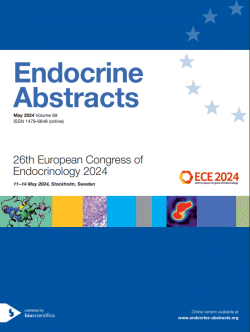
26th European Congress of Endocrinology
Stockholm,
Sweden
11 May 2024 - 14 May 2024

Oral Communications
Oral Communications 9: Pituitary and Neuroendocrinology | Part II
ea0099oc9.1 | Oral Communications 9: Pituitary and Neuroendocrinology | Part II | ECE2024
Differential gene expression in dopamine agonist sensitive and resistant human prolactinomas
Delgrange Etienne , Trouillas Jacqueline , Wierinckx Anne
ea0099oc9.2 | Oral Communications 9: Pituitary and Neuroendocrinology | Part II | ECE2024
Successful breastfeeding in a parturient with panhypopituitarism: A case report and literature review with implications for endocrine practice
Derdikman Ofir Yael , Eglash Anne , Moberg Kerstin , Hochberg Irit
ea0099oc9.3 | Oral Communications 9: Pituitary and Neuroendocrinology | Part II | ECE2024
Loss of heterozygosity predicts treatment-refractory behavior in pituitary neuroendocrine tumors
Lin Andrew , Rudneva Vasilisa , Richards Allison , Zhang Yanming , Rosenblum Marc , Donoghue Mark , Tabar Viviane , Geer Eliza
ea0099oc9.4 | Oral Communications 9: Pituitary and Neuroendocrinology | Part II | ECE2024
Kisspeptin administration does not alter anxiety or circulating cortisol levels in humans
Mills Edouard G , Thurston Layla , Yang Lisa , Suladze Sofiya , Hunjan Tia , Phylactou Maria , Patel Bijal , Clarke Sophie A. , Shah Amar J. , Izzi-Engbeaya Chioma , Tsoutsouki Jovanna , Bech Paul , Ertl Natalie , Demetriou Lysia , Wall Matthew B. , Goldmeier David , Abbara Ali , Comninos Alexander N. , Dhillo Waljit S.
ea0099oc9.5 | Oral Communications 9: Pituitary and Neuroendocrinology | Part II | ECE2024
Defining the role of androgen signalling in GABA neurons in the development of PCOS-like traits
Coyle Christopher , Prescott Melanie , Potapov Kyoko , Campbell Rebecca
ea0099oc9.6 | Oral Communications 9: Pituitary and Neuroendocrinology | Part II | ECE2024
Antiproliferative role of the vasopressin V2 receptor antagonist tolvaptan in a murine xenograft model of small cell lung cancer
Marroncini Giada , Naldi Laura , Polvani Simone , Pasella Francesca , Cirillo Chiara , Fibbi Benedetta , Peri Alessandro



